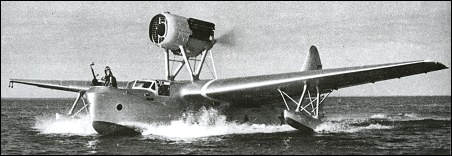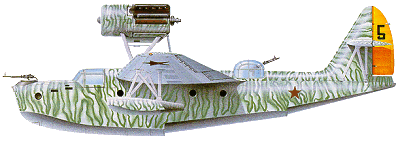 |
Beriev MBR-21932 |  |
| RECONNAISSANCE FLYING BOAT | Virtual Aircraft Museum / USSR / Russia / Beriev |
 |
Georgii Mikhailovich Beriev produced his first original design, Aircraft No. 25, at the Menzhinsky plant in Moscow in 1932. Beriev had gained considerable expertise as an assistant to French designer, Paul-Aime Richard, during the latter's stay in the Soviet Union from 1928 to 1930. The B.M.W. VIF-powered prototype was transported to Sevastopol on the Black Sea for flight tests, and these proving successful the new flying-boat went into production as the MBR-2 (Morskoy Blizhnii Razvedchik, or naval short-range reconnaissance). In production form it was powered by a Soviet-built M-17B inline engine. Deliveries of the MBR-2M-17 intended for use in the short-range bombing and maritime reconnaissance roles, began in 1934. It was a shoulder-wing cantilever monoplane, with its M-17B engine mounted on a pair of N-struts over the wing; it had a two-step wooden hull with plywood covering, and the pilot's cockpit located just in front of the wing. A strut-braced horizontal tailplane was set high on the single fin. Bow and midships gunners each had a single 7.62mm PV-1 machine-gun. VARIANTS Beriev MBR-2AM-34: in 1935, with the first production version already in service, Beriev carried out a radical redesign of the MBR-2; the pilot's cockpit was fully enclosed, and the midships gunner's position protected by a glazed cupola; the M-17B engine was replaced by the M-34NB (redesignated AM-34NB in 1937) of 619kW; an entirely new curved fin and rudder replaced the original angular vertical tailplane; and ShKAS machine-guns supplanted the obsolete PV-1s; the new version was. soon placed in large-scale production, which continued until 1942, when some 1,300 of all variants had been built; maximum speed of the MBR-2AM-34 was 245km/h, a considerable improvement over the initial production version; range was 800km, and service ceiling was raised to 7150m; weight empty increased to 2718kg and loaded weight was 4000kg; the MBR-2AM-34 served with all four main Soviet fleets and saw considerable service, first during the Winter War of 1939-40 with Finland, and then throughout the Great Patriotic War of 1941-5; it was tough, reliable and acquitted itself well; and it could be fitted with wheel or ski landing gear; post-war, the MBR-2 served for nearly a decade on fishery' patrol duties; it received the NATO codename 'Mote'. Beriev MBR-2M-103: in 1937 a standard MBR-2AM-34 was modified to take a more powerful M-103 engine, but no production of this version was undertaken Beriev MP-1: this was a civil passenger version of the MBR-2M-17; it carried six passengers in an enclosed cabin, or an equivalent weight of freight; used in some numbers by Soviet Civil Aviation Beriev MP-1bis: a 1937 civil development of the MBR-2AM-34, with similar capacity to that of the MP-1; one MP-1 bis, piloted by Paulina Osipenka, established a number of women's world records; between 22 and 25 May 1937 she attained respectively 7605m with a 500kg payload and 7000m with a 1000kg payload; on 2 July the same year she made a non-stop flight of 2416km between Novgorod and Archangelsk.

|  COMPANY PROFILE | ||||||||||||||||||||||||||||||||||||||||||||||||||||||||||
 |

|

 Olaf Bichel
Olaf Bichel
20
reply